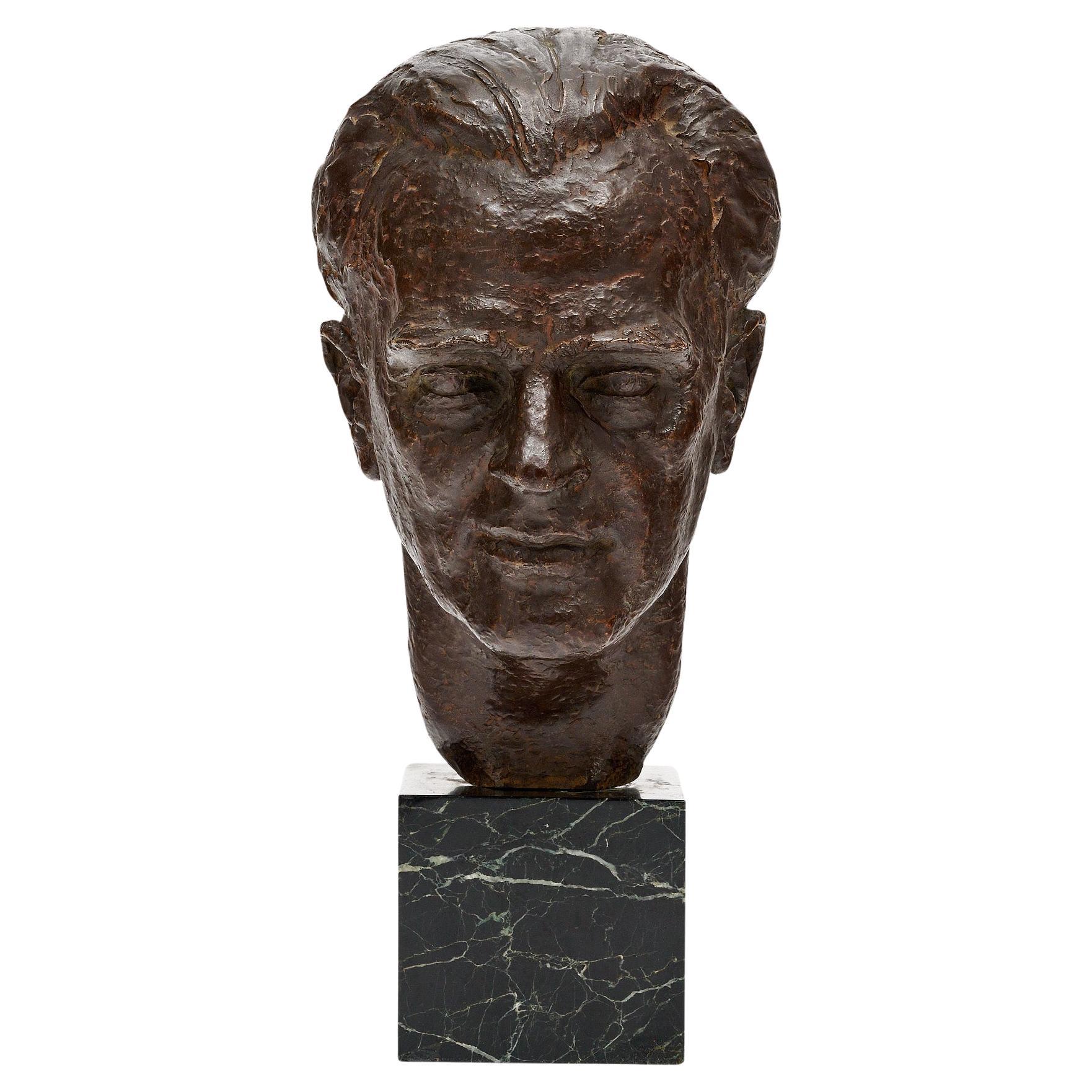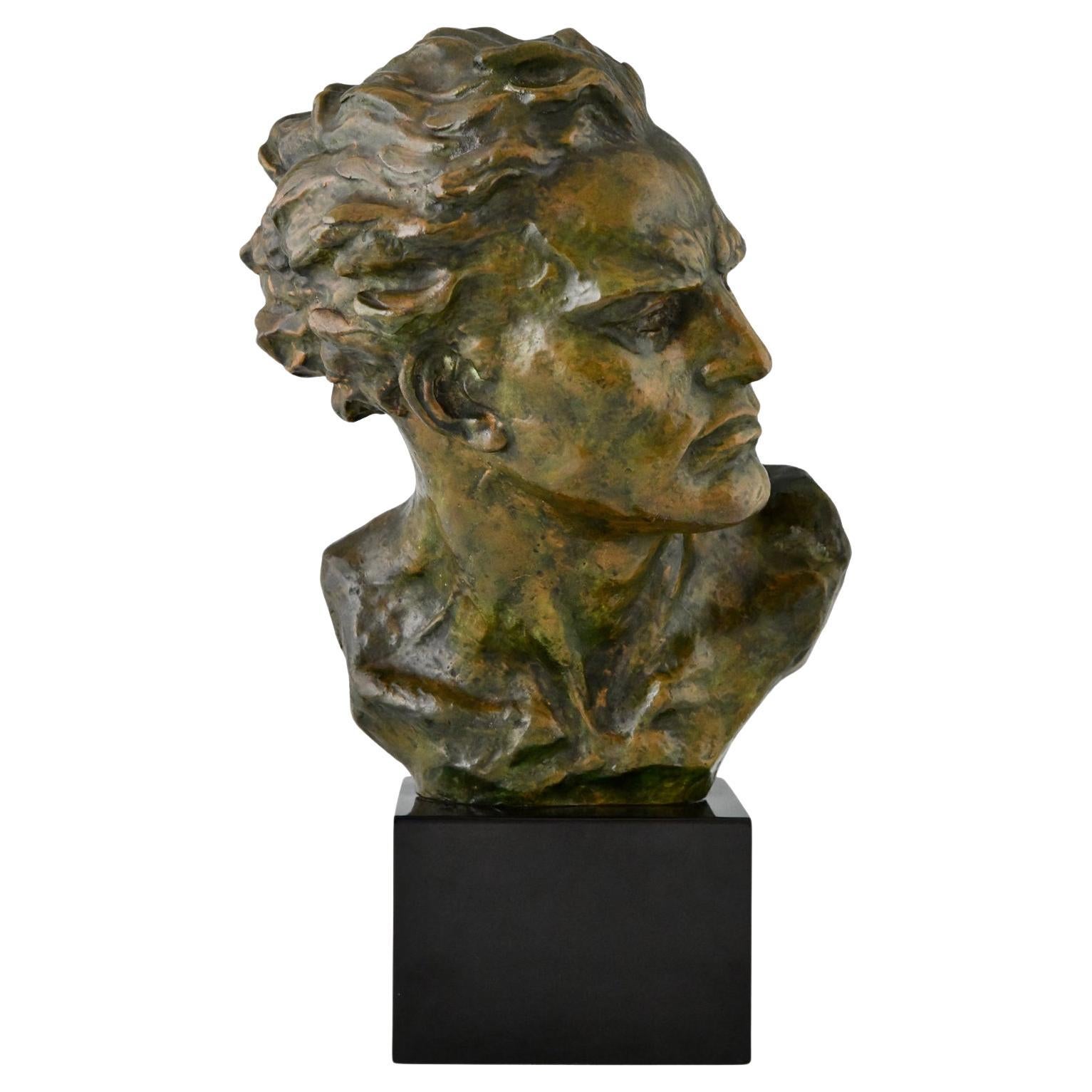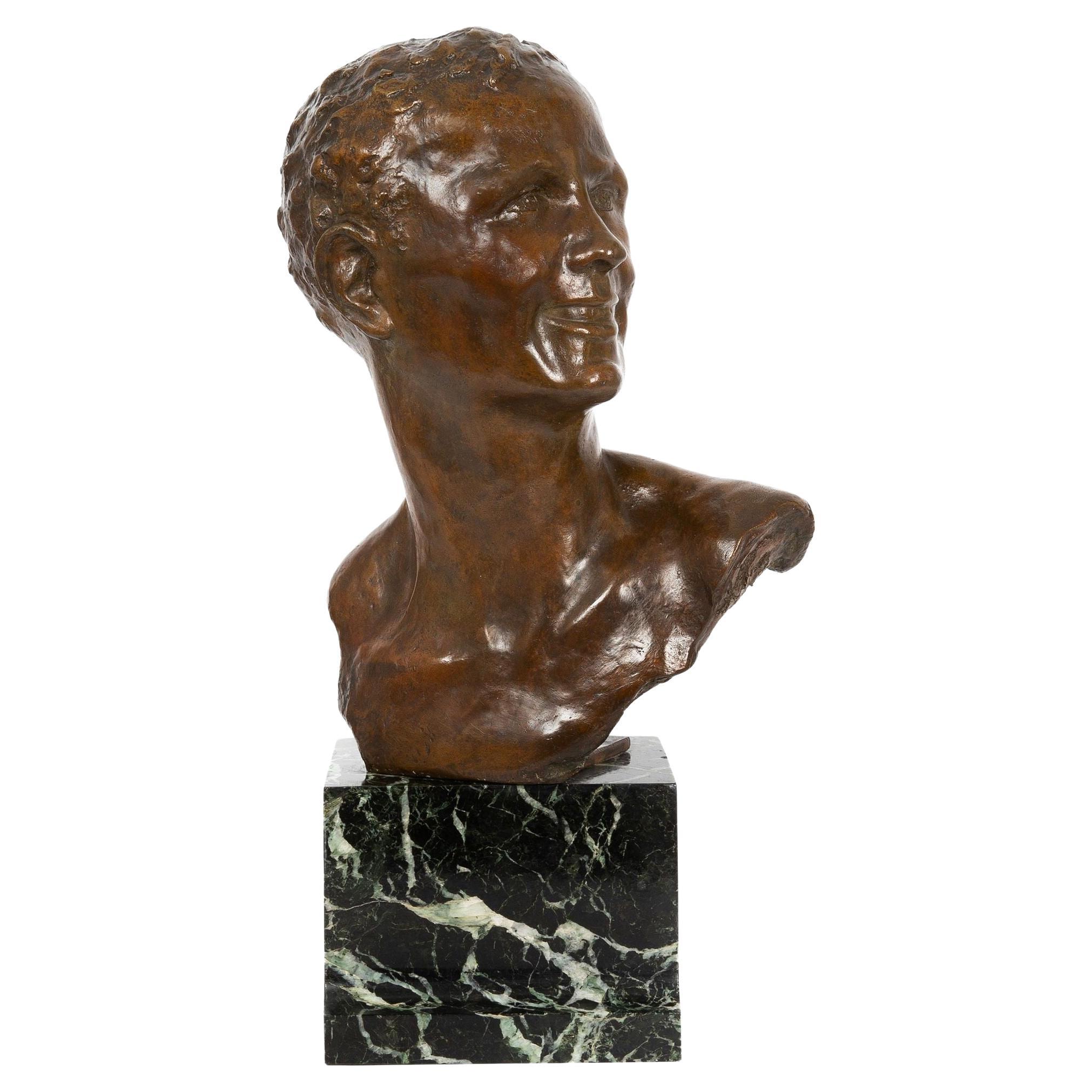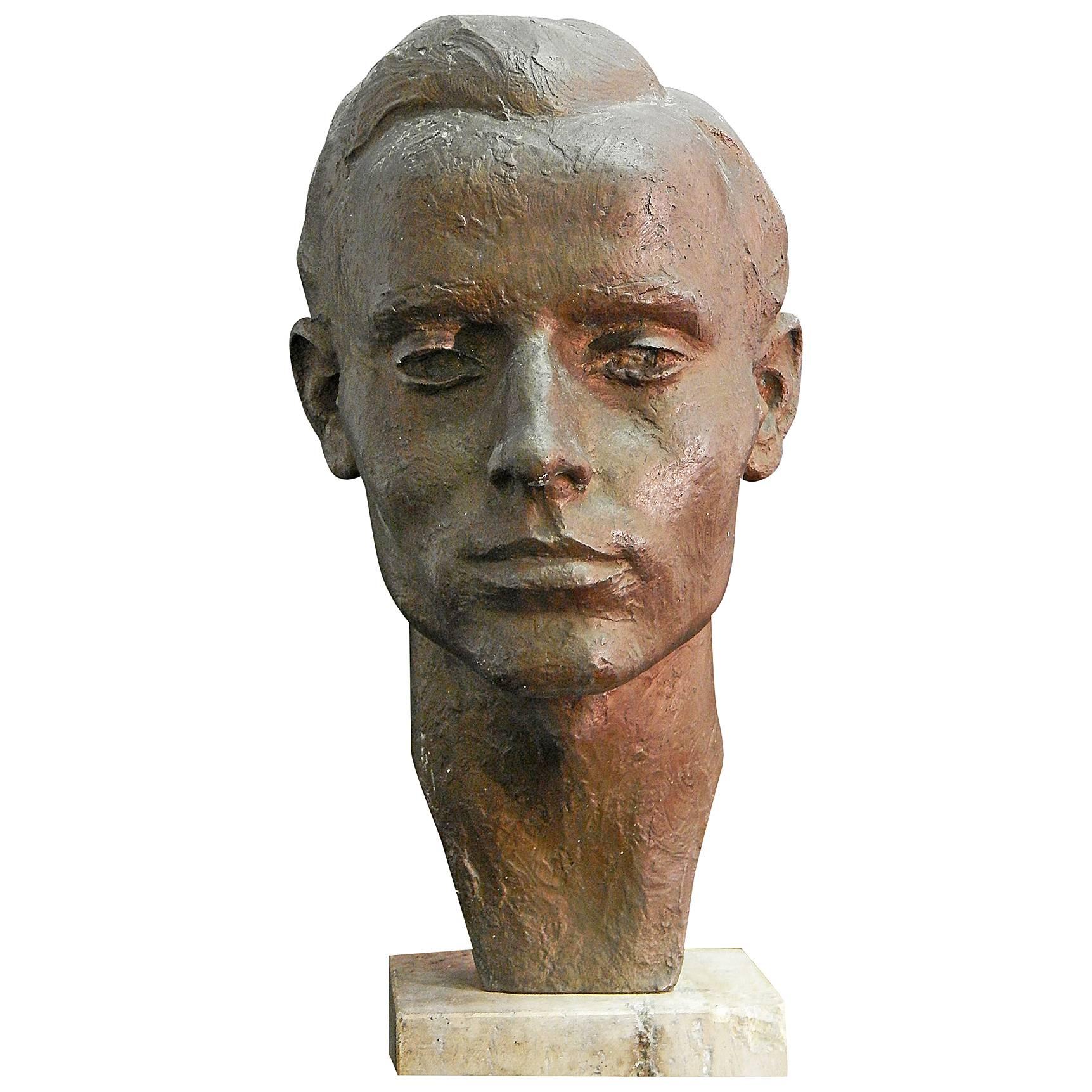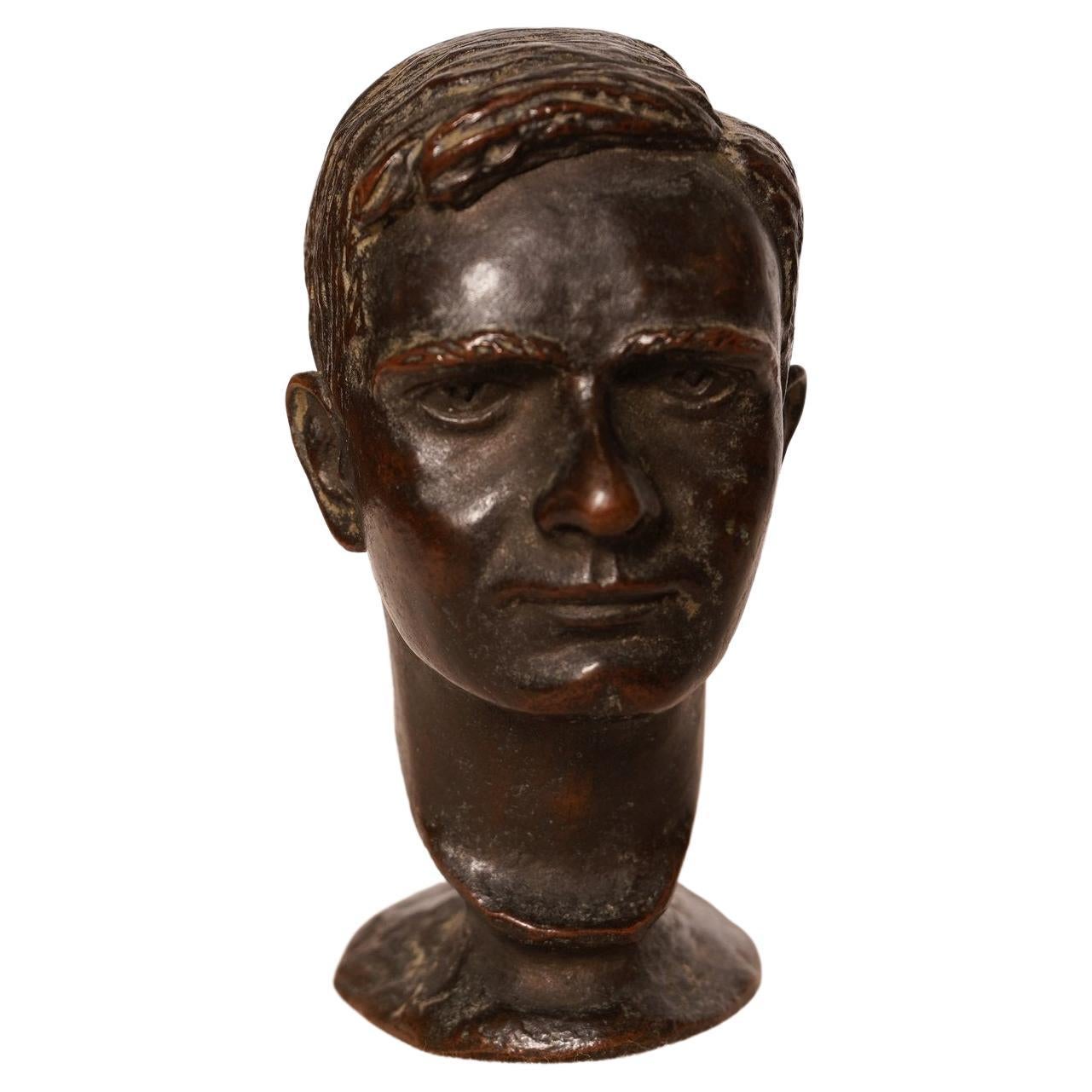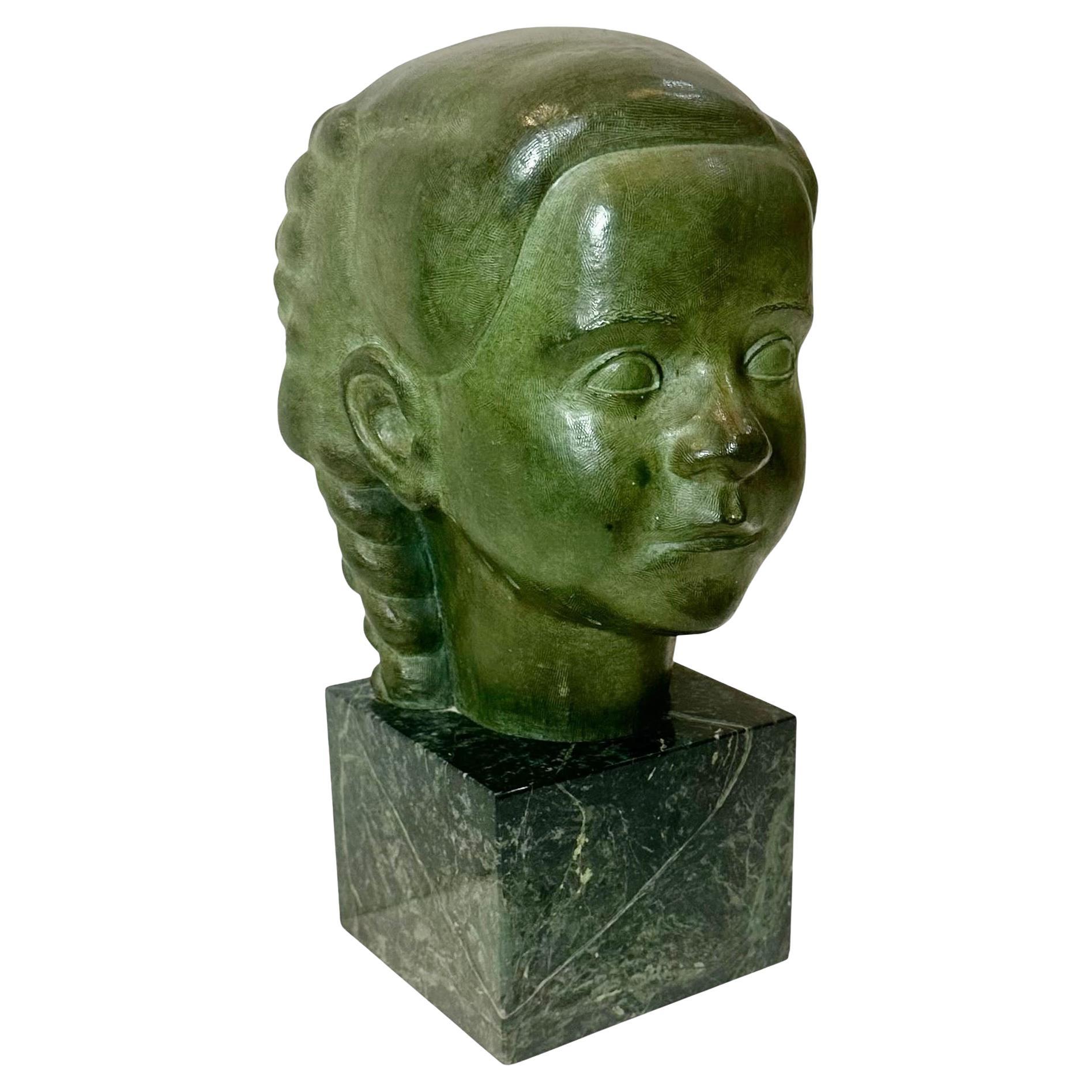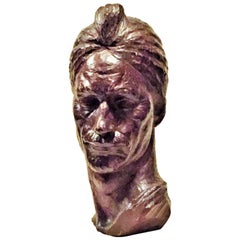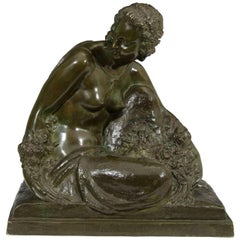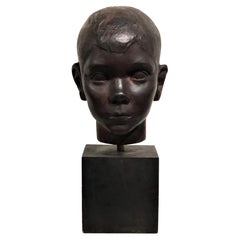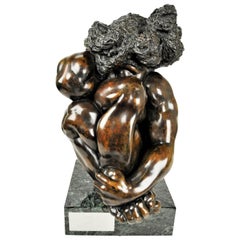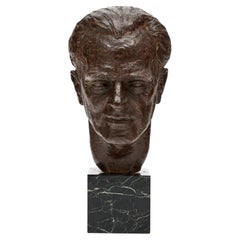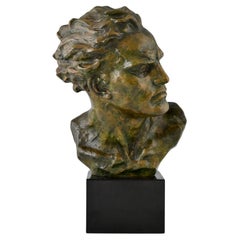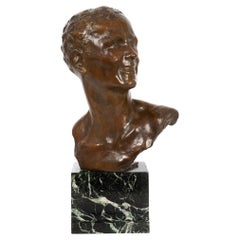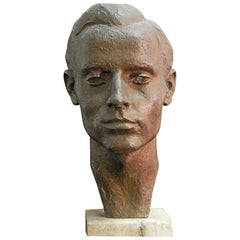Items Similar to Marina Núñez del Prado, Head, Patinated Bronze Sculpture, 1930s
Want more images or videos?
Request additional images or videos from the seller
1 of 6
Marina Núñez del Prado, Head, Patinated Bronze Sculpture, 1930s
$2,800
£2,126.83
€2,450.83
CA$3,943.09
A$4,371.50
CHF 2,297.39
MX$53,500.02
NOK 28,692.13
SEK 26,930.43
DKK 18,293.91
About the Item
Marina Núñez del Prado (1910-1995) was a celebrated Bolivian sculptor and one of the most respected sculptors from Latin America. Her work is highly sensuous, with rolling curves. She carved from native Bolivian woods, as well as black granite, alabaster, basalt and white onyx. Perhaps one of her most famous works is "White Venus" (1960), a stylized female body in white onyx. Another celebrated work is "Mother and Child," sculpted in white onyx. Indigenous Bolivian cultures inspired much of her work.
Marina Núñez Del Prado was born in La Paz, Bolivia on October 17, 1910. Del Prado first discovered her love of art in her youth while studying sculptural modeling techniques in La Paz. Her passion for sculpture was inspired by the work of Michelangelo, and she went on to study fine art at the Academy of Fine Arts in La Paz, graduating in 1930. She continued on at her alma mater as an instructor of artistic anatomy and sculpture. She became the first woman to achieve a position as the chair of the Academy.
While she was working at the Academy of Fine Arts, La Paz, Del Prado began exhibiting locally. She was very artistically active, and collaborated with various artists, such as Cecilio Guzmán de Rojas, a Bolivian painter who led the indigenous art movement at that time. Similarly Del Prado primarily focused her work on the rights of indigenous peoples and indigenismo, a political ideology centering the relationship of the indigenous population with the government.
Del Prado left her job at the university and her home city of La Paz to travel in 1938. She spent the next several years traveling through Peru, Uruguay, and Argentina. She then traveled to other countries outside of South America, including Egypt, parts of Europe, and the United States, where she studied for 8 years in New York on a fellowship awarded by the America Association of University Women.
While in New York, Del Prado won a Gold Medal for her exhibition “Miners in Rebellion.” This work was centered around the workers of the Bolivian region of Potosi. Shortly after this, in 1948, Del Prado moved back to La Paz, where she continued to make work inspired by the indigenous peoples of South America, as well as the landscape and culture of her homeland. She later moved to Peru in 1972, where she lived with her husband, Jorge Falcón, a writer native to Peru. With her four siblings, Del Prado donated the Casa Museo Marina Nuñez del Prado to the people of Bolivia in memory of her parents. The museum houses over a thousand works of art, mostly done by Del Prado and some by her sister, Nilda. Del Prado passed away in Lima, Peru in 1995.
In 1938 she left her post and traveled through Bolivia, Peru, Argentina, Uruguay, the United States, Europe, and Egypt. From 1940-1948, she worked and organized exhibitions of her work in the United States while on a scholarship. In 1946 "Miners in Revolt," inspired by the miners in Bolivia's Potosí Department, won a gold medal in a New York exhibition. In 1948 she returned to Bolivia, finally settling down in La Paz in 1958. By 1972 she moved to Peru where she lived with her husband, a Peruvian writer.
Along her successful career she met outstanding artists such as Pablo Picasso, Constantin Brâncu?i, poets Gabriela Mistral, Alfonsina Storni and Juana de Ibarbourou. She was also a friend of the Bolivian writer Franz Tamayo. Her work has been the subject of international and national critique. Botelho Gozalvez (1961) argues that her work is marked by two main characteristics: grace and strength. The strength is seen through her Andean landscapes and her grace is recognizable in the harmonious geometry of her works. Botelho claims that Nunez del Prado has a “genius loci” and distinguishes four periods in her work. The first period is characterized by the musical thematic of her work. The second period is characterized by the use of bidimensional sculpture and a social tematic. The third period is characterized by the tridimensional stone sculpture. It is also known as the ‘maternal’ period because of her aymara Madonnas and other depictions of indigenous women. Finally, the fourth period is the neo-abstract which has been influenced by Picasso, Archipenko and Milles. In similar fashion Hector Herazo Rojas (1962) argues that her works is characterized by strength, grace and monumentality He also points out that her works revolve around the thematic of race, myth and tradition. Her sculptures of indigenous motherly figures and mythic animals can attest to this. Pedro Querejazu (1996) coincides with Herazo Rojas on her race thematic and suggest that her sculptures originated within the movement of ‘native’ realism. According to him, her later her work adopted a modern and international expression which achieved a final stage immersed in the abstractism. This later work focused on the female figure and creatures of the Andes. On this later stage she worked with Amazonian tropical woods, bronze, and stones such as granite, andesite, basalt, onyx and marble. Other critics like Eduardo Mendoza Varela (1961), who reviewed her sculptures exhibition shown in the Luis Angel Arango library at the bank of the Republic of Colombia in Bogota Colombia, argues that her work is ‘miraculous’ and ‘mysterious’. His critique employs poetic metaphors to emphasize her skills and mastery of the materials in her sculptures. He considers the abstracted and reduced forms as possessing the ability to go beyond just physical representation but capture the spirit of the artist herself.
The critic Guillermo Nino de Guzman also refers to her work as ‘genius’ and a constant force of creative energy in regards to her series “Mujeres al Viento”(Página 7, 2014). Finally, her work has inspired poetry verses. The Spanish poet Rafael Alberti has dedicated an homage to her work.
Núñez Del Prado Museum
In the 1970s Marina Núñez del Prado established her residence and art studio in what would become the Museum Hose, located in 300 Ántero Aspillaga Street, right at the center of the El Olivar Forest. This neocolonial style building was conceived in 1926 by the engineer Luis Alayza and Paz Soldán and raised by the master builder Enrique Rodrigo, being one of the first buildings in the area. It became the first house in the whole of El Olivar to be declared National Cultural Heritage and in 1984 the house-museum of the Núñez del Prado Foundation was officially inaugurated in La Paz in honor of Marina Núñez del Prado's parents.
The House Museum governed by the Foundation Nuñez Del Prado, is a Private Museum that enriches the Bolivian heritage. For decades it was a home and studio to Marina Nunez del Prado, and now it has become the Casa Museo and a treasured place of history and talent to those of Bolivia. The museum contains 1,014 works by del Prado, which constitute the greater repository of her work including sculptures, drawings and sketches by Marina, thus making it the largest existing collection of her works. But within the museum you will not only find the work of Marina, but also that of her sister Nilda, who was a great goldsmith and painter. The museum is filled with their family environment, works of her father, and the collections of Bolivian Silver, Colonial Art, Contemporary Painting, and Handicrafts.
The house is surrounded by a garden of sculptures that had changing results affected by the urban modifications of its surroundings. It is composed of two levels being the first one of adobe and the second one of quincha brava. On the first floor there is a small central courtyard with a fused iron fountain. Its façade is colorful and on the right hand side, it reproduces, on a smaller scale, the front of the famous Palace of the Admiral of the city of Cusco. The workshop of the sculptor Marina Núñez, located on the second level, has been considered as the heart of the house and the intervention revolves around it.
For a large period of time the situation of the home museum of Marina Nunez del Prado was one of complication. At the time the museum had been closed and forgotten for almost 10 years due to lack of management and support. The closing was due to a break in its infrastructure during the initial construction of the American Tunnel and had remained closed to the public while many people claim the national or municipal government never took care of the situation. There exist many personal accounts of neighbors who had watched the museum remain neglected for years and described its importance to their community and art history. They speak highly of the museum and the work included as well as speak fondly of del Prado as an artist. In 2012 they published a note that restoration of the house would begin and that work was being done to solve the many architectural issues. It was reopened in April 2015 by the San Isidro District Council and the curatorial work made for the selection of the pieces being shown was made by Gustavo Buntinx.
- Creator:Marina Núñez del Prado (Sculptor)
- Dimensions:Height: 15 in (38.1 cm)Width: 9 in (22.86 cm)Depth: 11 in (27.94 cm)
- Style:Art Deco (Of the Period)
- Materials and Techniques:Bronze,Patinated
- Place of Origin:Bolivia
- Period:
- Date of Manufacture:1930s
- Condition:Wear consistent with age and use. Original wood base: 7.5 x 6 x 6 inches. We make our best effort to provide a fair and descriptive condition report. Please examine the photos attentively. Send us a message to request more details or discuss price.
- Seller Location:New York, NY
- Reference Number:1stDibs: LU2819311103921
About the Seller
5.0
Gold Seller
Premium sellers maintaining a 4.3+ rating and 24-hour response times
Established in 1993
1stDibs seller since 2017
85 sales on 1stDibs
Typical response time: 8 hours
- ShippingRetrieving quote...Shipping from: New York, NY
- Return Policy
Authenticity Guarantee
In the unlikely event there’s an issue with an item’s authenticity, contact us within 1 year for a full refund. DetailsMoney-Back Guarantee
If your item is not as described, is damaged in transit, or does not arrive, contact us within 7 days for a full refund. Details24-Hour Cancellation
You have a 24-hour grace period in which to reconsider your purchase, with no questions asked.Vetted Professional Sellers
Our world-class sellers must adhere to strict standards for service and quality, maintaining the integrity of our listings.Price-Match Guarantee
If you find that a seller listed the same item for a lower price elsewhere, we’ll match it.Trusted Global Delivery
Our best-in-class carrier network provides specialized shipping options worldwide, including custom delivery.More From This Seller
View AllF. Falcone, Orientale, Italian Art Deco Hand-Carved Wood Sculpture, circa 1925
Located in New York, NY
Signed on the side of the base, "F. Flacone" and "Orientale 1800", dated "1925".
Carved out inscription on the bottom of the base, "Chiavari". (Chiavari is a small town in the Pro...
Category
Vintage 1920s Italian Art Deco Figurative Sculptures
Materials
Wood
Marcel-André Bouraine, Nude, French Art Deco Bronze Sculpture, circa 1920s
By Marcel-André Bouraine
Located in New York, NY
An Art Deco bronze sculpture of a seated semi-nude woman by Marcel-André Bouraine, French, 1886-1948.
Category
Vintage 1920s French Art Deco Figurative Sculptures
Materials
Bronze
$4,550 Sale Price
30% Off
American Art Deco Carved Ebonized Wood Head Bust of a Young Boy, ca. 1940s
Located in New York, NY
ABOUT SCULPTURE
This wonderful sculptural and portrait work was certainly created by a master sculptor, although not signed by the author. The face of this typical all-American boy, ...
Category
Vintage 1940s American Art Deco Figurative Sculptures
Materials
Wood
Benson A. Selzer, Woman IX, Contemporary Patinated Bronze Sculpture, 1980s
By Benson A. Selzer
Located in New York, NY
Benson A. Selzer (1921-1999) was an American artist, known for sculpture and painting.
Category
Vintage 1980s American Modern Figurative Sculptures
Materials
Bronze
Italian Art Deco, Equestrian Groom, Patinated Bronze Sculpture, 1920s
Located in New York, NY
Signed on the base: “DITA”.
Impressed foundry stamp.
Category
Vintage 1920s Italian Art Deco Figurative Sculptures
Materials
Bronze
Vietnamese Art Deco Lacquered Bronze Bust of Asian Woman by Nguen Than, Ca. 1920
Located in New York, NY
Vietnamese Art Deco Lacquered Bronze Bust of Asian Woman by Nguen Than, Ca. 1920
Signed by the artist.
DIMENSIONS
Height: 7 inches
Width: 3.5 inches
Depth: 3 inches
ABOUT SCULPTUR...
Category
Vintage 1920s Vietnamese Art Deco Busts
Materials
Bronze
You May Also Like
Art Deco Period French Bronze Bust
Located in Austin, TX
Vintage bust from France made of bronze and supported by a marble base. This piece features the likeness of a man. It showcases the smelter’s stamp. This piece is in very nice vintag...
Category
Vintage 1940s French Art Deco Busts
Materials
Marble, Bronze
Art Deco Bronze Sculpture Male Bust Ugo Cipriani on marnel base France 1930
By Cipriani
Located in Antwerp, BE
Art Deco bronze sculpture male bust by Ugo Cipriani.
Patinated bronze.
Belgian black marble base.
France 1930.
Literatuur:
“Art Deco sculpture” Alastair Duncan.
Category
Mid-20th Century French Art Deco Busts
Materials
Belgian Black Marble, Bronze
French Art Deco Modernist Bronze Sculpture, Bust of Young Man, Alfredo Pina
By Alfredo Pina
Located in Shippensburg, PA
ALFREDO PINA
French, 1883-1966
Bust of a Young Man
Lost-wax cast medium-brown patinated bronze over solid verde marble plinth signed in cast "A. Pina" and sealed with cachet "cire...
Category
20th Century French Art Deco Busts
Materials
Marble, Bronze
"Head of Young Man, " Striking, Unique Bronze Sculpture by Bischoff, 1947
By August Bischoff
Located in Philadelphia, PA
Sculpted by August Bischoff and cast by the famous Brandis foundry in Dusseldorf, Germany, which also cast bronzes by important artists such as Arno Breker...
Category
Vintage 1940s German Art Deco Figurative Sculptures
Materials
Bronze
Bronze Head Sculpture
Located in Long Island City, NY
This bronze head sculpture signed by artist O. Ramsburg can be displayed as an elegant table top art piece.
Category
20th Century Mid-Century Modern Sculptures and Carvings
Materials
Bronze
$1,536
Mid Century Bronze Statue by J.G. Kendall, Cast by Gorham
Located in Tampa, FL
A beautifully cast mid century bronze statue by J.G. Kendall, produced by the renowned Gorham Company. Dating to the 1940s–1950s, this charming piece depicts a young girl with pigtai...
Category
Vintage 1950s American Busts
Materials
Marble, Bronze
More Ways To Browse
1930s Furniture New York
Patinated Bronze Figures
Female Head Sculpture
1930s Wood Sculpture
Bronze Head Female
Art Deco Head Sculpture
Worker Bronze
Art Deco Woman Head
Black Egypt Sculpture
Marble Well Head
White Onyx Sculpture
Stone Head Sculpture Hand Carved
Basalt Sculpture
Black Onyx Sculpture
Alabaster Sculpture Modern
Stone Well Head
Egyptian Head Sculpture
Art Deco Sculpture Onyx
